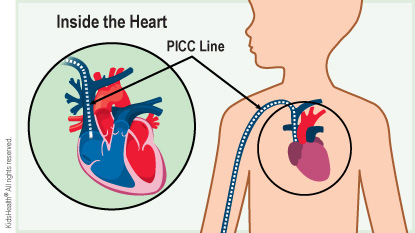A peripherally inserted central catheter (PICC line) is a thin tube that goes into a vein and threads all the way up through the vein and ends near or just inside the heart. It can be used to give a child medicine, fluids, blood, or nutrition. It also can be used to draw blood. There are caps on the PICC line where it comes out of the skin. These caps help keep germs out of the PICC line.
At home, a child's PICC line needs special care to prevent infection and keep it working well. It's normal to feel a little bit nervous about caring for the PICC line at first, but soon you'll feel more comfortable. These instructions will help you care for your child's PICC line.


Follow your health care team's recommendations for:
You'll get supplies to use at home, and a visiting nurse may come to help you when you first get home.

Your child has any of these signs that the PICC line is infected:
The line comes out or is not working.

Your child has trouble breathing, suddenly starts coughing, has chest pain, or their lips or nails look blue. These can be signs of a blood clot, which is a very rare problem that can happen from a PICC line.

Who gets a PICC line? A PICC line may be placed for someone:
Why is a PICC line used instead of a regular IV (intravenous) line? Health care providers might use a PICC line instead of a regular IV line because: